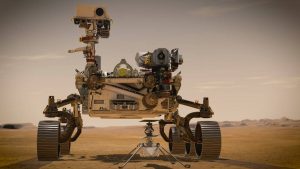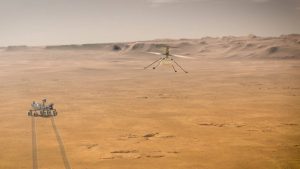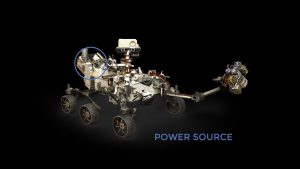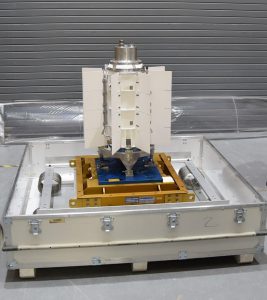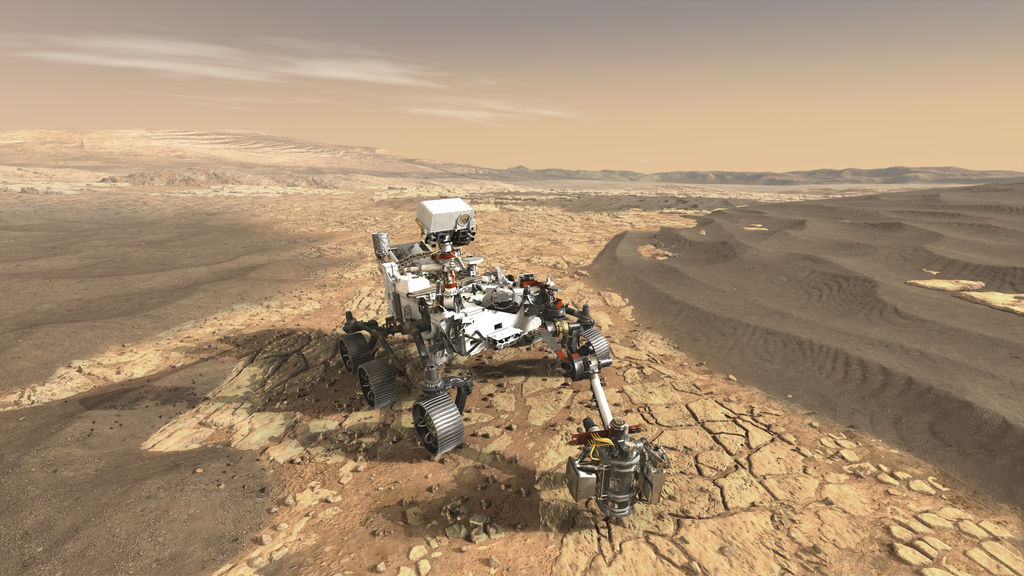
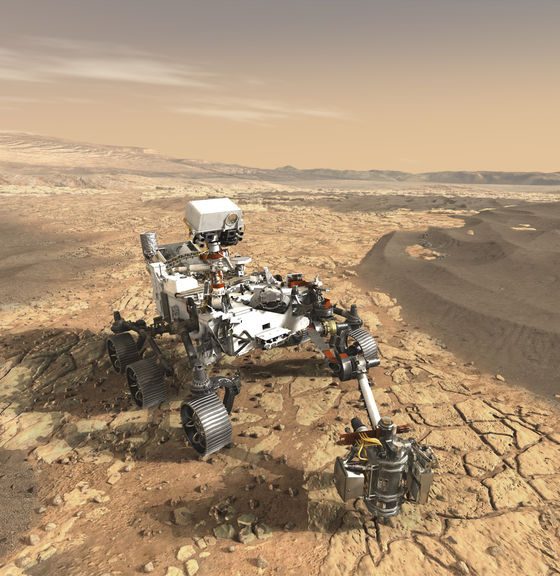
News
NASA’s Mars rover loaded up with nuclear power ahead of next week’s launch
NASA’s Perseverance rover destined for Mars next week has completed another step in preparation for launch – installation, and activation of its nuclear power source.
“The #MarsPerseverance MMRTG [multi-mission radioisotope thermoelectric generator] is installed and doing well. This Red Planet dune buggy is fueled and ready to go!” wrote Tory Bruno, CEO of launch provider ULA, via Twitter on Wednesday. He further clarified what this process means in response to a question about the power source. “RTGs [radioisotope thermoelectric generators] are ‘activated’ at the moment of assembly because the radio source continuously generates heat which solid state thermoelectric devices turn into voltage.”
While nuclear power may find itself in the middle of an ongoing debate on Earth, it’s an essential and frequently used source of energy for off-planet exploration. The decay of plutonium-238 provides the type of nuclear power being used for Perseverance. This process generates heat that’s converted into a 110W source of electricity to charge the rover’s two lithium-ion batteries. It will provide a 14-year lifespan, although the rover’s mission is scheduled to last less than two years.
- NASA’s Perseverance Rover and Ingenuity Helicopter depicted on Mars. | Credit: NASA/JPL
- The Ingenuity Helicopter that will accompany NASA’s newest Mars rover Perseverence. | Credit: NASA/JPL
- Where the MMRTG nuclear power source for NASA’s newest Mars rover will be located. | Credit: NASA/JPL
- The MMRTG nuclear power source for NASA’s newest Mars rover. | Credit: NASA/JPL
One of the most unique features of the Perseverance mission is a companion that will fly on the surface of the red planet: The Ingenuity Mars Helicopter. If successful, Ingenuity will be the first aircraft attempt at controlled flight outside of Earth.
These are big shoes to fill for such a tiny robot, the helicopter weighs only about 4 pounds with a body the size of a softball, but it may open up a whole new world of experimental possibilities. NASA also has plans to explore Saturn’s moon Titan using a similar helicopter in a future mission.
Another experiment onboard NASA’s latest rover that’s directly related to future human exploration is MOXIE (Mars Oxygen In-Situ Resource Utilization Experiment). As the description may indicate, this technology demonstration will produce oxygen using the existing carbon dioxide in Mars’ atmosphere. It’s a concept that has been proposed by both Martian habitation advocates and science fiction writers alike, and now the idea is ready to be put to a real (really real) world test.
Perseverance’s launch is currently scheduled for July 30th and will lift off from Cape Canaveral, Florida. About two weeks ago, the rover was encapsulated inside the payload fairing of the Atlas V 541 rocket that will carry it into space to begin its seven-month journey to Mars. Once there, Perseverance will use its specialized instruments onboard – including 19 cameras – to seek signs of both habitable conditions in the ancient past and signs of past microbial life.

News
Tesla FSD fleet is nearing 7 billion total miles, including 2.5 billion city miles
As can be seen on Tesla’s official FSD webpage, vehicles equipped with the system have now navigated over 6.99 billion miles.

Tesla’s Full Self-Driving (Supervised) fleet is closing in on almost 7 billion total miles driven, as per data posted by the company on its official FSD webpage.
These figures hint at the massive scale of data fueling Tesla’s rapid FSD improvements, which have been quite notable as of late.
FSD mileage milestones
As can be seen on Tesla’s official FSD webpage, vehicles equipped with the system have now navigated over 6.99 billion miles. Tesla owner and avid FSD tester Whole Mars Catalog also shared a screenshot indicating that from the nearly 7 billion miles traveled by the FSD fleet, more than 2.5 billion miles were driven inside cities.
City miles are particularly valuable for complex urban scenarios like unprotected turns, pedestrian interactions, and traffic lights. This is also the difference-maker for FSD, as only complex solutions, such as Waymo’s self-driving taxis, operate similarly on inner-city streets. And even then, incidents such as the San Francisco blackouts have proven challenging for sensor-rich vehicles like Waymos.
Tesla’s data edge
Tesla has a number of advantages in the autonomous vehicle sector, one of which is the size of its fleet and the number of vehicles training FSD on real-world roads. Tesla’s nearly 7 billion FSD miles then allow the company to roll out updates that make its vehicles behave like they are being driven by experienced drivers, even if they are operating on their own.
So notable are Tesla’s improvements to FSD that NVIDIA Director of Robotics Jim Fan, after experiencing FSD v14, noted that the system is the first AI that passes what he described as a “Physical Turing Test.”
“Despite knowing exactly how robot learning works, I still find it magical watching the steering wheel turn by itself. First it feels surreal, next it becomes routine. Then, like the smartphone, taking it away actively hurts. This is how humanity gets rewired and glued to god-like technologies,” Fan wrote in a post on X.
News
Tesla starts showing how FSD will change lives in Europe
Local officials tested the system on narrow country roads and were impressed by FSD’s smooth, human-like driving, with some calling the service a game-changer for everyday life in areas that are far from urban centers.

Tesla has launched Europe’s first public shuttle service using Full Self-Driving (Supervised) in the rural Eifelkreis Bitburg-Prüm region of Germany, demonstrating how the technology can restore independence and mobility for people who struggle with limited transport options.
Local officials tested the system on narrow country roads and were impressed by FSD’s smooth, human-like driving, with some calling the service a game-changer for everyday life in areas that are far from urban centers.
Officials see real impact on rural residents
Arzfeld Mayor Johannes Kuhl and District Administrator Andreas Kruppert personally tested the Tesla shuttle service. This allowed them to see just how well FSD navigated winding lanes and rural roads confidently. Kruppert said, “Autonomous driving sounds like science fiction to many, but we simply see here that it works totally well in rural regions too.” Kuhl, for his part, also noted that FSD “feels like a very experienced driver.”
The pilot complements the area’s “Citizen Bus” program, which provides on-demand rides for elderly residents who can no longer drive themselves. Tesla Europe shared a video of a demonstration of the service, highlighting how FSD gives people their freedom back, even in places where public transport is not as prevalent.
What the Ministry for Economic Affairs and Transport says
Rhineland-Palatinate’s Minister Daniela Schmitt supported the project, praising the collaboration that made this “first of its kind in Europe” possible. As per the ministry, the rural rollout for the service shows FSD’s potential beyond major cities, and it delivers tangible benefits like grocery runs, doctor visits, and social connections for isolated residents.
“Reliable and flexible mobility is especially vital in rural areas. With the launch of a shuttle service using self-driving vehicles (FSD supervised) by Tesla in the Eifelkreis Bitburg-Prüm, an innovative pilot project is now getting underway that complements local community bus services. It is the first project of its kind in Europe.
“The result is a real gain for rural mobility: greater accessibility, more flexibility and tangible benefits for everyday life. A strong signal for innovation, cooperation and future-oriented mobility beyond urban centers,” the ministry wrote in a LinkedIn post.
News
Tesla China quietly posts Robotaxi-related job listing
Tesla China is currently seeking a Low Voltage Electrical Engineer to work on circuit board design for the company’s autonomous vehicles.

Tesla has posted a new job listing in Shanghai explicitly tied to its Robotaxi program, fueling speculation that the company is preparing to launch its dedicated autonomous ride-hailing service in China.
As noted in the listing, Tesla China is currently seeking a Low Voltage Electrical Engineer to work on circuit board design for the company’s autonomous vehicles.
Robotaxi-specific role
The listing, which was shared on social media platform X by industry watcher @tslaming, suggested that Tesla China is looking to fill the role urgently. The job listing itself specifically mentions that the person hired for the role will be working on the Low Voltage Hardware team, which would design the circuit boards that would serve as the nervous system of the Robotaxi.
Key tasks for the role, as indicated in the job listing, include collaboration with PCB layout, firmware, mechanical, program management, and validation teams, among other responsibilities. The role is based in Shanghai.
China Robotaxi launch
China represents a massive potential market for robotaxis, with its dense urban centers and supportive policies in select cities. Tesla has limited permission to roll out FSD in the country, though despite this, its vehicles have been hailed as among the best in the market when it comes to autonomous features. So far, at least, it appears that China supports Tesla’s FSD and Robotaxi rollout.
This was hinted at in November, when Tesla brought the Cybercab to the 8th China International Import Expo (CIIE) in Shanghai, marking the first time that the autonomous two-seater was brought to the Asia-Pacific region. The vehicle, despite not having a release date in China, received a significant amount of interest among the event’s attendees.
